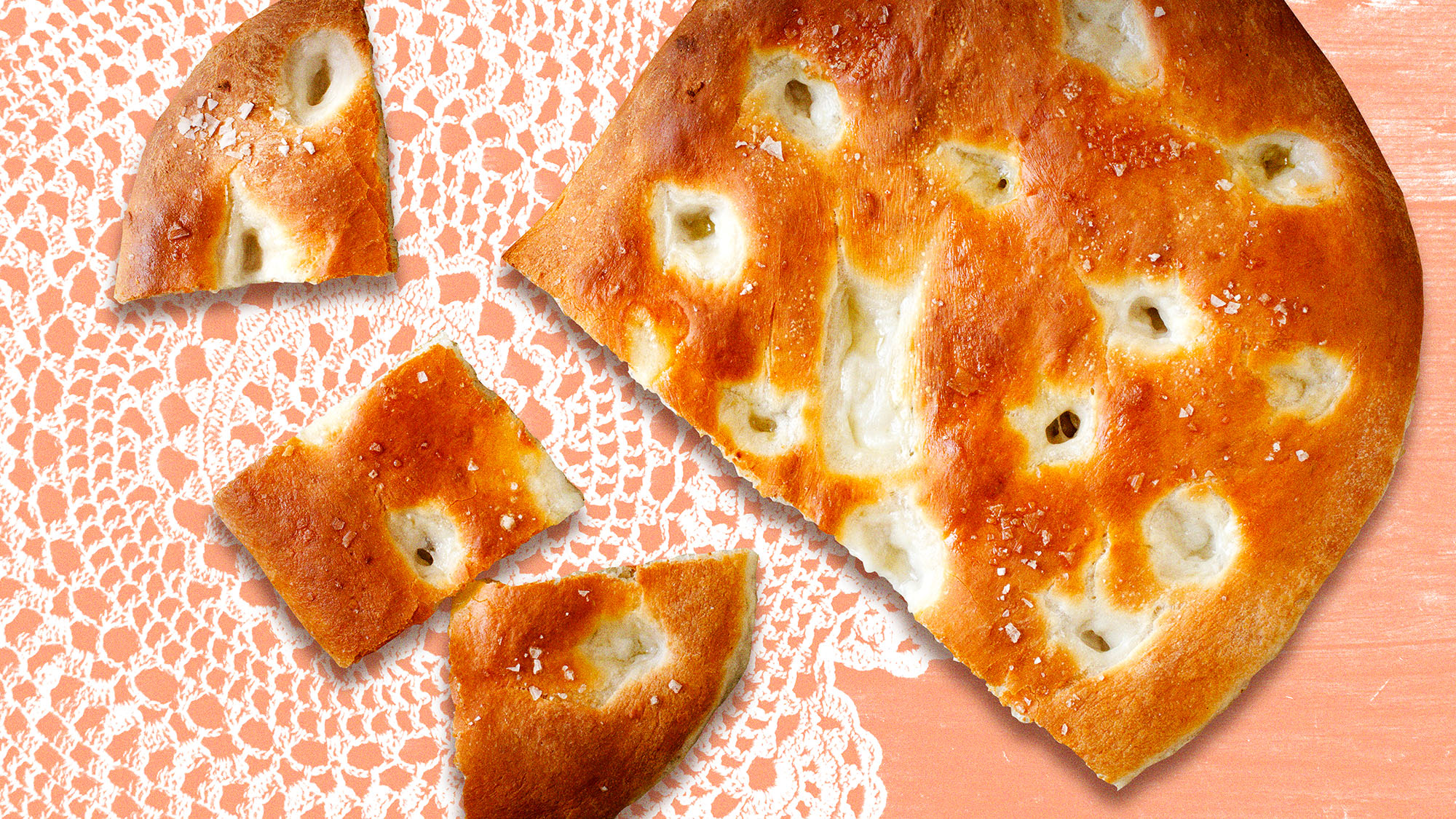My Nonna's Focaccia Tastes Like Love Soaked In Olive Oil
I've eaten homemade focaccia nearly every Sunday of my life. Sunday dinner in most Italian-American families, mine included, is one tradition from the old country that has stayed alive through the generations. Every week growing up, my extended family crowded into my grandparents' kitchen and pulled chairs up to long folding tables covered in intricate white tablecloths protected by plastic covers. The meal consisted of homemade sauce on top of pasta, braciole and wine; followed by fruit, pastries, and espresso; washed down with tiny bottles of red bitters and topped off with half a pack of Pall Malls (by the adults, of course).
But, the opening to this sacred meal was my personal favorite—my Nonna's focaccia. In my family's native Mola Di Bari, Italy, there is no such thing as day-old bread. Bakers roll out fresh loaves on a daily basis (why don't I live there?), and the idea of eating old bread is straight-up offensive. So on Sundays when bakers take the day off, people make focaccia, because God forbid they go a day without bread. I love hearing about the tradition of residents bringing their focaccia pans to the town oven and to bake them there, communally. You could see a row of 20 focaccia cooking at once inside the ovens.

But my Nonna's focaccia is the most perfect focaccia of all. Some categorize it as Focaccia Barese; some argue that focaccia is focaccia. Either way, hers has the perfect crunch from the oil pooling at the bottom of the pan, plus a crusty top and a warm, chewy inside. Each slice has a peeled chunk of tomato on top, which sits in another pool of oil inside of a dimple made from the chef's perfectly pudgy thumb or knuckle (the pudgy hand is the key instrument used in many of my family's beloved recipes). Some people add Kalamata olives on top of their focaccia in addition to tomatoes, making it taste saltier. I'm not saying I'll be mad at those of you who do this, but my all I can say is Nonna never did that.
The best part about Nonna was that she took at least one ingredient or one trick from her recipes to the grave with her. So, for the past decade or so, my dad and I have been on a quest to replicate her focaccia. I think we've finally cracked it.

Nonna’s Sunday Focaccia
- 1.25 lbs. bread flour (plus more to knead)
- 2 tsp. salt
- 2 cups warm water (less than 100 degrees Fahrenheit)
- 1 tsp. sugar
- 2 Tbsp. active dry yeast
- Extra-virgin olive oil
- 1 can (28 oz.) peeled or diced tomatoes
Using a stand mixer, preferably with a bread hook, add the flour and mix in the salt. In a separate bowl, stir sugar into the water and then stir in the yeast. Let sit for 10 minutes to activate. Pour the liquid into the dry ingredients and mix until combined.
Once your dough is made, form it into a ball, score an "x" into the top of it with a knife or razor, and place it in a bowl coated with flour to prevent sticking. Cover with plastic wrap and allow to rise for 1 to 3 hours (closer to 3 hours is usually better), until it's doubled its size. I suggest wrapping your favorite blanket around the bowl with and storing it in a warm corner. Read it a poem or play it a song (optional).
Once you start kneading it on a flour-coated surface, you'll be able to tell if the dough is "nervous" or not. Nervous dough means it's "tense"—less fluffy. If you pull it out of the bowl and there's not a lot of stuck, residual dough that's been left behind—then it's tighter and tougher. If that's the case, allow it to rise a bit longer. Tense dough with less bounce back effect will lead to a less fluffy finished product, but it's still acceptable.
Coat the bottom of a 12-14 inch round baking pan with a generous amount of olive oil. Once you consider it to be a generous amount, add some more. Place your dough in the center of the pan and coat your hands in olive oil so you can manually work the dough out evenly to the edges of the pan. Then, use your knuckle or thumb and poke dimples in the dough. Using fresh tomatoes or canned, peeled whole tomatoes in a bowl, gently muddle them with a spoon to release the natural juices. Spoon the tomatoes into the dimples of the dough, and drizzle the tomato juices across the top at will. Grab that olive oil once again and give it a nice drizzle or brush it evenly on top. Cover with plastic wrap and allow to rise an additional 1 hour in a warm, dark area or in an unheated oven, while preheating your oven to 500 degrees Fahrenheit.
Bake the focaccia for 25 minutes, and do not open that oven to check on the bread until at least 15 minutes has passed. Once fully baked, flip the pan upside down to let your oily focaccia slip out onto a baking rack. Turn right side up. Slice and serve warm.
